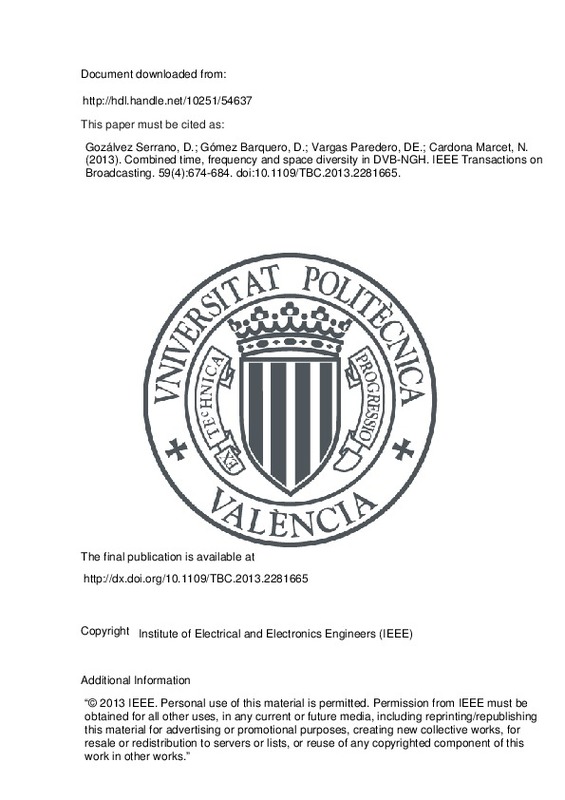JavaScript is disabled for your browser. Some features of this site may not work without it.
Buscar en RiuNet
Listar
Mi cuenta
Estadísticas
Ayuda RiuNet
Admin. UPV
Combined time, frequency and space diversity in DVB-NGH
Mostrar el registro sencillo del ítem
Ficheros en el ítem
| dc.contributor.author | Gozálvez Serrano, David
|
es_ES |
| dc.contributor.author | Gómez Barquero, David
|
es_ES |
| dc.contributor.author | Vargas Paredero, David Eduardo
|
es_ES |
| dc.contributor.author | Cardona Marcet, Narciso
|
es_ES |
| dc.date.accessioned | 2015-09-15T08:49:32Z | |
| dc.date.available | 2015-09-15T08:49:32Z | |
| dc.date.issued | 2013-12 | |
| dc.identifier.issn | 0018-9316 | |
| dc.identifier.uri | http://hdl.handle.net/10251/54637 | |
| dc.description | “© 2013 IEEE. Personal use of this material is permitted. Permission from IEEE must be obtained for all other uses, in any current or future media, including reprinting/republishing this material for advertising or promotional purposes, creating new collective works, for resale or redistribution to servers or lists, or reuse of any copyrighted component of this work in other works.” | es_ES |
| dc.description.abstract | In this paper, we investigate the combined use of time, frequency, and space diversity in DVB-NGH, the next generation mobile broadcasting standard. Compared to current standards like DVB-H or DVB-SH, the largest improvement in next generation systems is expected to be achieved by means of better diversity in the time, frequency, and space domains. In this sense, DVB-NGH is the first broadcasting system to exploit the use of diversity in the three domains by incorporating at the physical layer long time interleaving (TI), time-frequency slicing (TFS), and multiple-input multiple-output (MIMO). This paper investigates the gains of using time, frequency, and space diversity in DVB-NGH, as well as the mutual influence between the different types of diversity. To this purpose, we employ an information-theoretic approach based on the outage capacity of the channel in addition to physical layer simulations. | es_ES |
| dc.language | Inglés | es_ES |
| dc.publisher | Institute of Electrical and Electronics Engineers (IEEE) | es_ES |
| dc.relation.ispartof | IEEE Transactions on Broadcasting | es_ES |
| dc.rights | Reserva de todos los derechos | es_ES |
| dc.subject | Diversity | es_ES |
| dc.subject | DVB-H | es_ES |
| dc.subject | DVB-NGH | es_ES |
| dc.subject | DVB-SH | es_ES |
| dc.subject | Time interleaving | es_ES |
| dc.subject | Multiple-input multiple-output | es_ES |
| dc.subject | Time-frequency slicing | es_ES |
| dc.subject.classification | TEORIA DE LA SEÑAL Y COMUNICACIONES | es_ES |
| dc.title | Combined time, frequency and space diversity in DVB-NGH | es_ES |
| dc.type | Artículo | es_ES |
| dc.identifier.doi | 10.1109/TBC.2013.2281665 | |
| dc.rights.accessRights | Abierto | es_ES |
| dc.contributor.affiliation | Universitat Politècnica de València. Instituto Universitario de Telecomunicación y Aplicaciones Multimedia - Institut Universitari de Telecomunicacions i Aplicacions Multimèdia | es_ES |
| dc.contributor.affiliation | Universitat Politècnica de València. Departamento de Comunicaciones - Departament de Comunicacions | es_ES |
| dc.description.bibliographicCitation | Gozálvez Serrano, D.; Gómez Barquero, D.; Vargas Paredero, DE.; Cardona Marcet, N. (2013). Combined time, frequency and space diversity in DVB-NGH. IEEE Transactions on Broadcasting. 59(4):674-684. doi:10.1109/TBC.2013.2281665 | es_ES |
| dc.description.accrualMethod | S | es_ES |
| dc.relation.publisherversion | http://dx.doi.org/10.1109/TBC.2013.2281665 | es_ES |
| dc.description.upvformatpinicio | 674 | es_ES |
| dc.description.upvformatpfin | 684 | es_ES |
| dc.type.version | info:eu-repo/semantics/publishedVersion | es_ES |
| dc.description.volume | 59 | es_ES |
| dc.description.issue | 4 | es_ES |
| dc.relation.senia | 257053 | es_ES |
| dc.identifier.eissn | 1557-9611 |







![[Cerrado]](/themes/UPV/images/candado.png)

